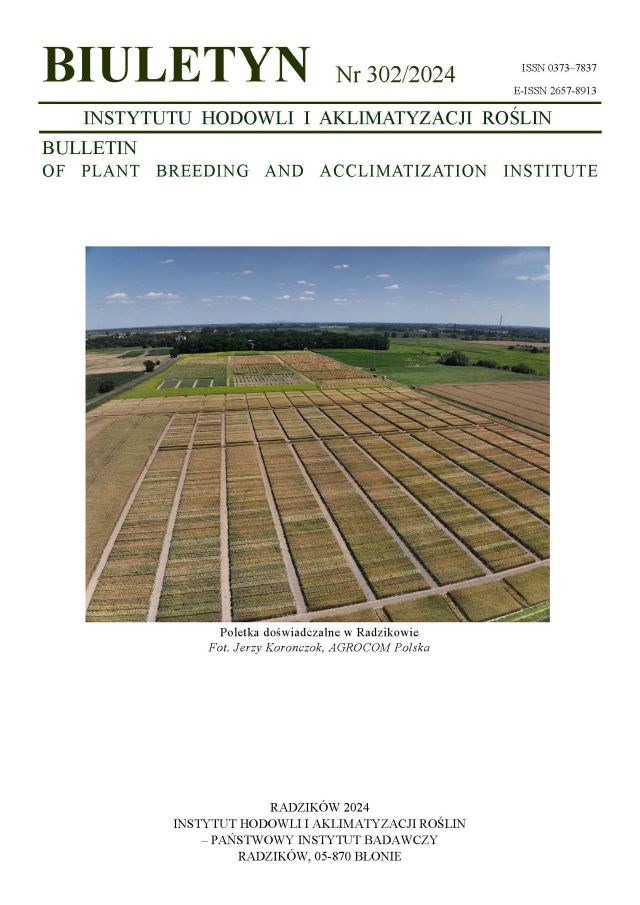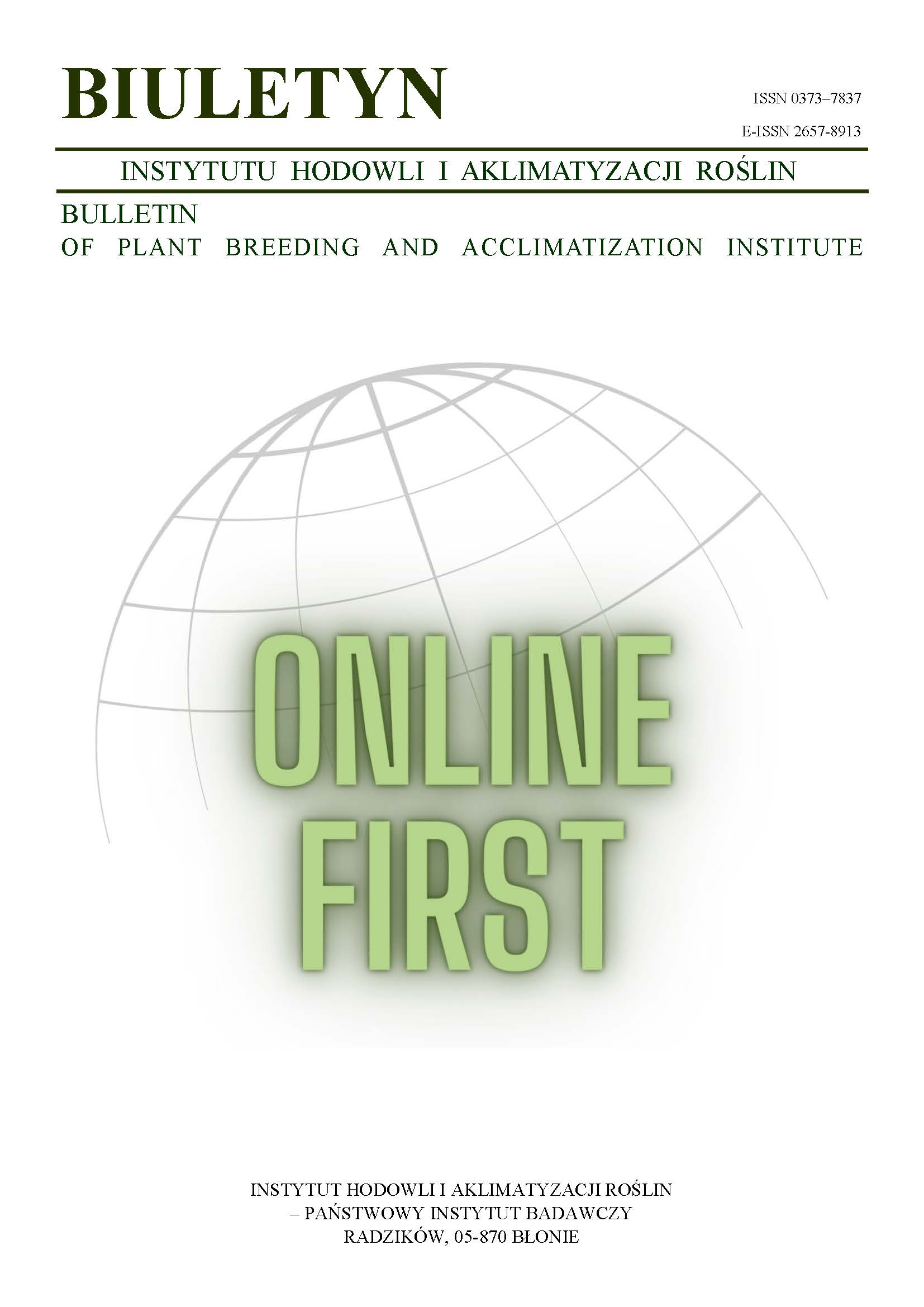Możliwości wykorzystania krzyżowania introgresywnego w hodowli pszenicy ozimej Triticum aestivum L.
Część II. Efektywność w ulepszaniu cech kłosa i jakości ziarna
Józef Pilch
j.pilch@ihar.edu.plZakład Oceny Jakości i Metod Hodowli Zbóż, Instytut Hodowli i Aklimatyzacji Roślin w Krakowie (Poland)
Abstrakt
Praca przedstawia możliwości wykorzystania krzyżowania introgresywnego dla potrzeb hodowli pszenicy ozimej T. aestivum L. poprzez wytwarzanie materiałów wyjściowych. W części II pracy przedstawiono korzystne dla hodowli efekty uzyskane w krzyżowaniu introgresywnym w oparciu o systemy genetyczne pszenicy T. aestivum L. Obejmują one ulepszenia kłosa pod względem długości (cm), liczby kłosków, liczby kwiatków w kłosku, liczby ziaren, masy ziarna (g) i parametrów technologicznych ziarna jak zawartość białka ogółem (%), wskaźnik sedymentacji (ml), liczba opadania (s). Wartości tych cech nie uzyskano dotychczas metodami rekombinacyjnymi w hodowli. Wskazano wytworzone materiały, które mogą być wykorzystane w hodowlanych programach krzyżowań pszenicy ozimej. W krzyżowaniu introgresywnym gatunki obce T. boeoticum Boiss., T. timopheevii Zhukov. v. 5013, 5030, T. dicoccoides Schweinf., T. durum Desf. vs. Mirable, Khapli, Fuensemiduro, Mutico Mucur, DF624, Ae. speltoides Taush., L. perenne L. v. Anna, E. giganteus L. okazały się efektywnymi źródłami zarówno dla ulepszeń cech kłosa jak również jakości ziarna.
Słowa kluczowe:
Triticum aestivum L., cechy kłosa, gatunki obce, hybrydyzacja introgresywna, parametry technologiczne, ziarno, ulepszeniaBibliografia
Anamthawat-Jonsson K. 1999. Variable genome composition in Triticum × Leymus amphiploids. Theor. Appl. Genet. 99 (7–8): 1087 — 1093.
DOI: https://doi.org/10.1007/s001220051313
Google Scholar
Anderson O. D., Litts J. C., Greene F. C. 1997. The L-gliadin gene family. I. Characterization of ten new wheat L-gliadin genomic clones, evidence for limited sequence conservation of flanking DNA and Southern analysis of gene family. Theor. Appl. Genet. 95: 50 — 58.
DOI: https://doi.org/10.1007/s001220050531
Google Scholar
Anderson O. D., Abraham-Pierce F. A., Tam A. 1998. Conservation in wheat high-molecular-weight glutenin gene promotor sequences: comparisons among loci and among alleles of the Glu-B1-1 locus. Theor. Appl. Genet. 96: 568 — 576.
DOI: https://doi.org/10.1007/s001220050775
Google Scholar
Ban T. 1997. Evaluation of resistance to Fusarium head blight indigenous Japanese species of Agropyron (Elymus). Euphytica 97: 39 – 44.
DOI: https://doi.org/10.1023/A:1003078109694
Google Scholar
Belea A., Sagi F. 1978. Evaluation of common wheats and interspecific Triticum hybrids for protein and lysine content. Cereal Res. Comm. Vol. 6, no. 1: 15 — 19.
Google Scholar
Bluthner W. D., Schumann E. 1988. Use of Aegilops and tetraploid wheat for wheat protein improvement. Hod. Rośl. Aklim. 32, 1–2: 203 — 206.
Google Scholar
Bojarczuk J. 2005. Pszenica T. durum Desf. w Polsce, genetyka, hodowla i wykorzystanie do produkcji makaronu. Biul. IHAR (w druku).
Google Scholar
Borghi B., Pogna N. E., Ambrogio E. 1998. Bread wheat. Italian Contribution to Plant Genetics and Breeding (Eds. G. T. Scarascia Mugnozza, M. A. Pagnotta), Univ. of Tuscia, Italy: 195 — 207.
Google Scholar
Branlard G., Autran J. C., Monneveux P. 1989. High molecular weight glutenin subunits in durum wheat (Triticum durum). Theor. Appl. Genet. 78: 353 — 358.
DOI: https://doi.org/10.1007/BF00265296
Google Scholar
Buerstmayr H., Lemmens L., Grausgruber H., Ruckenbauer P.1996. Scab resistance of international wheat germplasm.. Cer. Res. Comm. 24: 195 — 202.
Google Scholar
Cherkaoui S., Lamsaoui O., Chlyah A., Chlyah H. 2000. Durum wheat × maize crosses for haploid wheat production: Influence of parental genotypes and various experimental factors. Plant Breed. 119: 31 — 36.
DOI: https://doi.org/10.1046/j.1439-0523.2000.00433.x
Google Scholar
Ciaffi M., Benedeltelli S., Giorgi B., Porceddu E., Lafiandra D. 1991. Seed storage proteins of Triticum turgidum spp. dicoccoides and their effects on technological quality in durum wheat. Plant Breeding, 107: 309 — 319.
DOI: https://doi.org/10.1111/j.1439-0523.1991.tb00554.x
Google Scholar
Ciaffi M., Dominici L., Lafiandra D., Porceddu E. 1992. Seed storage proteins of wild wheat progenitors and their relationships with technological properties. Hereditas, 116: 315 — 322.
DOI: https://doi.org/10.1111/j.1601-5223.1992.tb00844.x
Google Scholar
Cygankiewicz A. 1997. Wartość technologiczna ziarna materiałów hodowlanych pszenicy ozimej i jarej na tle badań własnych i światowych. Biul. IHAR 204: 219 — 235.
Google Scholar
D’Ovidio R., Tanzarella O.A., Masci S., Lafiandra D., Porceddu E. 1992. RFLP and PCR analysis at Gli-1, Gli-2, Glu-1 and Glu-3 loci in cultivated and wild wheats. Hereditas 116: 79 — 85.
DOI: https://doi.org/10.1111/j.1601-5223.1992.tb00803.x
Google Scholar
D’Ovidio R, Simeone M., Masci S., Porceddu E. 1997. Molecular characterization of a LMW-GS gene located on chromosome 1B and the development of primers specific for the Glu-B3 complex locus in durum wheat. Theor. Appl. Genet. 95: 119 — 126.
DOI: https://doi.org/10.1007/s001220050671
Google Scholar
Farooq S,. Iqbal N., Asghar M., Shah T. M. 1992. Intergeneric hybridization for wheat improvement. IV. Expression of salt tolerance gene(s) of Aegilops cylindrica in hybrids with hexaploid wheat. Cereal Res. Comm. 20, 1-2:111 — 118.
Google Scholar
Forde J., Malpica J. M., Halford N. G., Shevry P. R., Anderson O. D., Green F. C. (1985). The nucleotide sequence of a HMW glutenin subunit gene located on chromosome 1A of wheat (Triticum aestivum L.) Nucleic Acids Res. 13: 6817 — 6832.
DOI: https://doi.org/10.1093/nar/13.19.6817
Google Scholar
Friebe B., Raup W. J., Gill B. S. 1997. Alien sources for diseases and pest resistance in wheat improvement. In: Lelley T. (ed.). Current topics in plant cytogenetics related to plant improvement, Tulln-Austria: 63 — 71.
Google Scholar
Hsam S. L. K., Mohler V., Hartl L., Wenzel G., Zeller F. J. 2000. Mapping of powdery mildew and leaf rust resistance genes on the wheat-translocated chromosome T 1BL-1RS using molecular and biochemical markers. Plant Breed. 119: 87 — 89.
DOI: https://doi.org/10.1046/j.1439-0523.2000.00444.x
Google Scholar
Juhasz A., Larroque O.R., Tamas L., Hsam S. L. K., Zeller F. J., Bekes F., Bedo Z. 2003. Bankuti 1201-an old Hungarian wheat variety with special storage protein composition. Theor. Appl. Genet. 107: 697 — 704.
DOI: https://doi.org/10.1007/s00122-003-1292-2
Google Scholar
Kaczyński L. 2002. Pszenica ozima. Lista opisowa odmian 2002. COBORU, Słupia Wielka: 20 — 35.
DOI: https://doi.org/10.1038/nbt0102-35
Google Scholar
Kazman M. E., Lein V., Robbelen G. 1997. The 1BL-1RS translocation in recently developed European wheats. In: Lelley T. (ed.). Current topics in plant cytogenetics related to plant improvement, Tulln-Austria: 334 — 341.
Google Scholar
Khan I. A. 2000. Molecular and agronomic characterization of wheat — Agropyron Intermedium recombinant chromosomes. Plant Breed. 119: 25 — 29.
DOI: https://doi.org/10.1046/j.1439-0523.2000.00440.x
Google Scholar
Klockiewicz-Kamińska E., Brzeziński W. J. 1997. Metoda oceny i klasyfikacji jakościowej odmian pszenicy. Wiad. Odm. COBORU, Słupia Wielka, 67: 1 — 18.
Google Scholar
Kushnir U., Halloran G. M. 1984. Transfer of high kernel weight and high protein from wild tetraploid wheat (Triticum turgidum dicoccoides) to bread wheat with recombination. Euphytica 33: 249 — 255.
DOI: https://doi.org/10.1007/BF00022773
Google Scholar
Lange W., Jochemsen G. 1979. Use of wild emmer (Triticum dicoccoides, AA BB) in the breeding of common wheat (Triticum aestivum L. AA BB DD). Proc. Conf. Broadening Genet. Base Crops, Wageningen: 225 — 227.
Google Scholar
Lima-Brito J., Guedes-Pinto H., Harisson G. E., Heslop-Harisson J. S. 1996. Chromosome identification and nuclear architecture in triticale × tritordeum F1 hybrids. J. of Exp. Bot., Vol. 47, No. 297: 583 — 588.
DOI: https://doi.org/10.1093/jxb/47.4.583
Google Scholar
Mc Intosh R. A., Lagudah E. S. 2000. Cytogenetical studies in wheat. XVIII. Gene Yr 24 for resistance to stripe rust. Plant Breed. 119: 81 — 83.
DOI: https://doi.org/10.1046/j.1439-0523.2000.00449.x
Google Scholar
Pilch J. 1987. Substytucje i delecje heterochromatynowe chromosomów żyta (Secale cereale L.) oraz ich związek z niektórymi cechami użytkowymi pszenżyta heksaploidalnego. Hod. Rośl. Aklim. 30, 3–4: 1 — 52.
Google Scholar
Pilch J., Głowacz E. 1997. Międzygatunkowe i międzyrodzajowe krzyżowania jako sposób ulepszania cech kłosa w hodowli pszenicy heksaploidalnej Triticum aestivum L. Biul. IHAR 204: 15 — 31.
Google Scholar
Pilch J. 2002. Wartość technologiczna introgresywnych form pszenicy ozimej (Triticum aestivum L.). Biul. IHAR 223/224: 95 — 109.
Google Scholar
Pilch J. 2004. Wykorzystanie hybrydyzacji introgresywnej w podwyższaniu wartości technologicznej ziarna pszenicy ozimej Triticum aestivum L. Pam. Puł. 135: 247 — 257.
Google Scholar
Reeves C. D., Okita T. W. 1987. Analyses of L, B — gliadin genes from diploid and hexaploid wheats. Gene 52: 257 — 266.
DOI: https://doi.org/10.1016/0378-1119(87)90052-7
Google Scholar
Rogers W. J., Rickatson J. M., Sayers E. J., Law C. N. 1990. Dosage effects of chromosomes of homoeologous groups 1 and 6 upon bread-making quality in hexaploid wheat. Theor. Appl. Genet. 80: 281 — 287.
DOI: https://doi.org/10.1007/BF00224399
Google Scholar
Rogers W. J., Miller T. E., Payne P. I., Seekings J. A., Sayers E. J., Holt L. M., Law C. N. 1997. Introduction to bread wheat (Triticum aestivum L.) and assessment for bread-making quality of alleles from T. boeoticum Boiss ssp. Thaoudar at Glu-A1 encoding two high-molecular-weight subunits of glutenin. Euphytica 93: 19 — 27.
DOI: https://doi.org/10.1023/A:1002991206350
Google Scholar
Rubiales D., Ballesteros J., Martin A. 1992 Resistance to Septoria tritici in Hordeum chiloense × Triticum spp. amphiploids. Plant Breed. 109: 281 — 286.
DOI: https://doi.org/10.1111/j.1439-0523.1992.tb00186.x
Google Scholar
Sao Q. Q., Deng W. Y., Lin X. Y. 1989. Wide crossing and gene transfer methods between species. In: Mujeeb-Kazi A., Sitch A.L. (eds). Review of Advances in Plant Biotechnology 1985–1988., CIMMYT-Mexico: 115 — 131.
Google Scholar
Schlegel R. 1997. Current list of wheats with rye introgressions of homoeologous group 1. 2nd update. Wheat Inf. Service No. 84: 64 — 69.
Google Scholar
Szafer W., Kulczyński S., Pawłowski B. 1967. Rośliny polskie. Wyd. PWN Warszawa: 930 – 931.
Google Scholar
Szwed-Urbaś K., Segit Z., Mazurek H. 1997. Parametry jakościowe ziarna krajowych linii pszenicy twardej (Triticum durum Desf.). Biul. IHAR 204: 129 — 140.
Google Scholar
Turchetta T., Ciaffi M., Porceddu E., Lafiandra D. 1995. Relationship between electrophoresis pattern of storage proteins and gluten strength in durum wheat landraces from Turkey. Plant Breed. 114: 406 — 412.
DOI: https://doi.org/10.1111/j.1439-0523.1995.tb00821.x
Google Scholar
Trottet M., Dosba F. 1983. Analyses cytogenetique et comportement vis-a-vis de Septoria nodorum d“ hybrides Triticum sp. × Aegilops squarrosa et de leurs descendances. Agronomie 37: 659 — 664.
DOI: https://doi.org/10.1051/agro:19830707
Google Scholar
Vallega V., Mello-Sampayo T. 1987. Variation of high-molecular-weight glutenin subunits amongst cultivars of Triticum turgidum L. from Portugal. Euphytica 3: 755 — 762.
DOI: https://doi.org/10.1007/BF00051858
Google Scholar
Zeven A. C., Waninge J. 1986. The degree of similarity backcross lines of Triticum aestivum cultivars Manitou and Neepawa with Aegilops speltoides accessions as donors. Euphytica 35: 677 — 685.
DOI: https://doi.org/10.1007/BF00028575
Google Scholar
Zillman R.R., Bushuk W. 1979. Wheat cultivar identification by gliadin electrophoregrams. III. Can. J. Plant Sci. 59: 287.
DOI: https://doi.org/10.4141/cjps79-048
Google Scholar
Autorzy
Józef Pilchj.pilch@ihar.edu.pl
Zakład Oceny Jakości i Metod Hodowli Zbóż, Instytut Hodowli i Aklimatyzacji Roślin w Krakowie Poland
Statystyki
Abstract views: 51PDF downloads: 33
Licencja
Prawa autorskie (c) 2005 Józef Pilch

Utwór dostępny jest na licencji Creative Commons Uznanie autorstwa – Na tych samych warunkach 4.0 Miedzynarodowe.
Z chwilą przekazania artykułu, Autorzy udzielają Wydawcy niewyłącznej i nieodpłatnej licencji na korzystanie z artykułu przez czas nieokreślony na terytorium całego świata na następujących polach eksploatacji:
- Wytwarzanie i zwielokrotnianie określoną techniką egzemplarzy artykułu, w tym techniką drukarską oraz techniką cyfrową.
- Wprowadzanie do obrotu, użyczenie lub najem oryginału albo egzemplarzy artykułu.
- Publiczne wykonanie, wystawienie, wyświetlenie, odtworzenie oraz nadawanie i reemitowanie, a także publiczne udostępnianie artykułu w taki sposób, aby każdy mógł mieć do niego dostęp w miejscu i w czasie przez siebie wybranym.
- Włączenie artykułu w skład utworu zbiorowego.
- Wprowadzanie artykułu w postaci elektronicznej na platformy elektroniczne lub inne wprowadzanie artykułu w postaci elektronicznej do Internetu, lub innej sieci.
- Rozpowszechnianie artykułu w postaci elektronicznej w internecie lub innej sieci, w pracy zbiorowej jak również samodzielnie.
- Udostępnianie artykułu w wersji elektronicznej w taki sposób, by każdy mógł mieć do niego dostęp w miejscu i czasie przez siebie wybranym, w szczególności za pośrednictwem Internetu.
Autorzy poprzez przesłanie wniosku o publikację:
- Wyrażają zgodę na publikację artykułu w czasopiśmie,
- Wyrażają zgodę na nadanie publikacji DOI (Digital Object Identifier),
- Zobowiązują się do przestrzegania kodeksu etycznego wydawnictwa zgodnego z wytycznymi Komitetu do spraw Etyki Publikacyjnej COPE (ang. Committee on Publication Ethics), (http://ihar.edu.pl/biblioteka_i_wydawnictwa.php),
- Wyrażają zgodę na udostępniane artykułu w formie elektronicznej na mocy licencji CC BY-SA 4.0, w otwartym dostępie (open access),
- Wyrażają zgodę na wysyłanie metadanych artykułu do komercyjnych i niekomercyjnych baz danych indeksujących czasopisma.
Inne teksty tego samego autora
- Józef Pilch, Efektywność introgresji genów Glu-1 wysokocząsteczkowych glutenin w zwiększaniu wartości wypiekowej ziarna zbóż — przegląd literatury , Biuletyn Instytutu Hodowli i Aklimatyzacji Roślin: Nr 243 (2007): Wydanie regularne
- Józef Pilch, Introgresje genów z gatunków spokrewnionych taksonomicznie w ulepszeniach pszenicy Triticum aestivum L. i innych roślin uprawnych , Biuletyn Instytutu Hodowli i Aklimatyzacji Roślin: Nr 260/261 (2011): Wydanie regularne
- Józef Pilch, Wykorzystanie genów z gatunków diploidalnych, tetraploidalnych i heksaploidalnych pszenicy Triticum L. w odmianach pszenicy heksaploidalnej Triticum aestivum L. , Biuletyn Instytutu Hodowli i Aklimatyzacji Roślin: Nr 262 (2011): Wydanie regularne
- Józef Pilch, Genetyczne możliwości ulepszania jakości ziarna pszenicy ozimej Triticum aestivum L. w efekcie hybrydyzacji introgresywnej z Triticum durum Desf. , Biuletyn Instytutu Hodowli i Aklimatyzacji Roślin: Nr 236 (2005): Wydanie regularne
- Józef Pilch, Możliwości wykorzystania krzyżowania introgresywnego w hodowli pszenicy ozimej Triticum aestivum L. , Biuletyn Instytutu Hodowli i Aklimatyzacji Roślin: Nr 235 (2005): Wydanie regularne
- Józef Pilch, Wpływ genomów A, B Triticum durum Desf. na wartość technologiczną ziarna pszenicy ozimej Triticum aestivum L. , Biuletyn Instytutu Hodowli i Aklimatyzacji Roślin: Nr 230 (2003): Wydanie regularne
- Józef Pilch, Uwarunkowania genetyczne cech morfologicznych kłosa pszenicy (Triticum aestivum L.) , Biuletyn Instytutu Hodowli i Aklimatyzacji Roślin: Nr 228 (2003): Wydanie regularne














